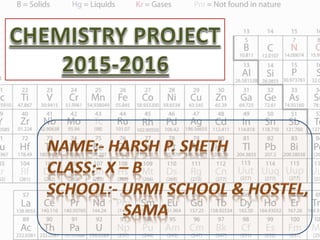
Chemistry project Class 10 CBSE(Periodic Table)
- 3. I. What is Periodic table II. Need for classification of elements III.Dobereiner’s Triads IV.Newland’s Law of Octaves V. Mendeleev’s Periodic Table VI.Modern Periodic Table VII.Trends in Modern Periodic Table CONTENTS
- 4. • It is the tabular display of elements organized on the basis of atomic number, Electronic configurations and chemical properties. • The table also shows four rectangular blocks: s-, p- d- and f-block. In general, within one row (period) the elements are metals on the left hand side, and non-metals on the right hand side. • The rows of the table are called periods; the columns are called groups.
- 5. In the year 1800, only 30 elements were known. Now, at present, there are 114 elements known. So, it became difficult for the scientist to remember all the properties of elements. Therefore, there was a need to classify elements. Many scientist tried to classify elements based different criteria. Some brought success while some did not as we will see in further slides.
- 8. • In 1817, Johann Dobereiner tried to classify elements with similar properties into groups. • He found some groups having 3 elements each. So he called these groups ‘Triads’. • He showed when three elements in a triad were written in order of increasing atomic masses, the atomic mass of the middle element was roughly average of atomic mass of the other two elements.
- 10. Example of Dobereiner’s Triad: Element Atomic mass Lithium: 7amu Sodium: 23amu Potassium: 39amu So, this is one example of his triad. In this triad atomic mass of sodium is average of the other two atomic mass. i.e. 7+39/2 = 46/2 = 23amu. Limitation of his Triad: Dobereiner could only find three such triads from the elements known at that time. Thus this system of classification was not found to be useful.
- 12. • Newland arranged element according to their increasing atomic mass. • He found out that every eight element had properties similar to first. This came to be known as Newlands’ law of octave. • Example: Lithium and Sodium were found to be same.
- 14. Limitations • Law of octave was only applicable up to calcium as after every eight element did not have same properties to that of first. • He assumed that only 56 element existed and no more elements were to be discovered. • In order to fit elements into the table, Newlands’ adjusted two elements like cobalt and nickel in the same slot and also put some unlike elements under the same note. So this law only worked well with lighter elements hence it was not applicable with elements have atomic mass above 40u
- 16. • He arranged elements on the bases of Atomic mass and chemical properties. • He selected hydrogen and oxygen and reacted every elements with it and formed its compounds. • Compounds of hydrides and oxides were treated as one of the basic properties of an element for its classification. • He formulated Periodic Law: Properties of elements are the periodic function of their atomic mass.
- 18. • Predicted existence of some elements that were not discovered at that time. Eg: Gallium, Scandium and Germanium. • Predict properties of elements on basis of its position. • Nobel gases which were discovered later could fit in his table. Achievements of Mendeleev
- 19. LIMITATIONS OF MENDELEEV’S TABLE • Position of the Isotopes could not be explained. • Wrong order of atomic mass could not be explained in some case. Eg: Cobalt(58.9) came before Nickle(58.7). • Hydrogen was not assigned correct position. It had properties of both alkali and Halogens.
- 21. • In 1913 Henry Moseley showed that atomic number of an element was more fundamental property than atomic mass. • Modern periodic law: Properties of elements are the periodic function of their atomic number.
- 22. • Modern periodic table consists of 18 groups and 7 periods. • Through the modern periodic table: 1. Position of isotope is clear. 2. Position of Nickle and cobalt is clear. 3. Position of hydrogen is well explained.
- 24. Trends in Periods • Period – Horizontal rows of element in a periodic table are called periods. Trends :- 1. Valence electron : From left to right number of valence electron increases. 2. Atomic Number : From left to right there is consecutive atomic number. 3. Valency : From left to right Valency increases from 1 to 4 and then decrease to 0. 4. Atomic size : Decreases from left to right. 5. Metallic Character : Metallic character decreases from left to right. 6. Chemical reactivity : From left to right, decreases then increases. 7. Nature of oxides : From left to right basic character decreases and then acidic character increases.
- 25. Trends in Groups • Group – Vertical columns in periodic table is known as groups. Trends :- 1. Valence Electron : Have same number of valence electron. 2. Valency : Elements in a group have a same Valency. 3. Atomic size : Increases from up to down. 4. Metallic Character : On going down metallic character increases. 5. Chemical Reactivity : On going down chemical reactivity of metal increases but chemical reactivity of non metal decreases. 6. Nature of oxides : All elements in group has same nature of oxides.
